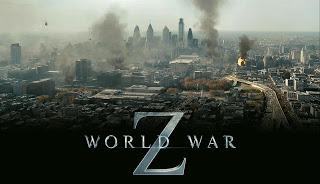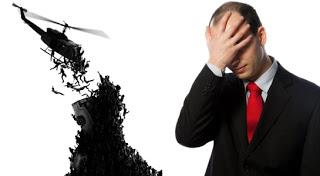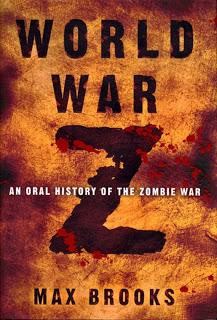
The Lowdown: World War Z is the biggest and blandest zombie apocalypse film I’ve seen. Based on the best-selling novel by Max Brooks, the film retains the book’s title, but not much else. Really, this film is about as far removed from the book as it could possibly get, and that’s a crying shame. World War Z could have been groundbreaking for the zombie movie genre, but instead, the filmmakers decided to make it a conventional, uninspired, uneven action blockbuster. The kicker? It’s PG-13. That’s just great.
1. The Plot: The film follows Gerry (Brad Pitt), a United Nations operative who becomes embroiled in the zombie apocalypse. After escaping a devastated New Jersey and taking refuge on a U.S. Navy vessel along with his family, the military officers in charge recruit him to track down the initial source of the virus outbreak. His search leads him around the world, from South Korea to Israel, and it becomes a race against time to find a cure and stop the virus from causing human extinction. What’s the problem with this plot? Well for starters, it is almost nothing like the book that it is based on. Instead of a standard three-act narrative, the novel by Max Brooks is a collection of startlingly realistic, first-person accounts of the aftermath of the zombie apocalypse. The various passages in the novel describe the drastic political, environmental, and social changes that occur. These accounts provide social commentary on government and corporate corruption, as well as an examination on the basic human instincts of fear, uncertainty, and survival. This take on the zombie genre is both unique and captivating. I would have been much happier seeing a zombie movie that played out like a series of interviews rather than a blockbuster filled with chases, explosions, and people screaming. In all fairness, I understand that World War Z underwent a great deal of reshoots because the script underwent drastic rewrites. My hypothesis is that rewrites were necessary to 1) make the film more commercial, and 2) tone the film down to a PG-13.

This about sums up how I feel about that decision.
2. The Characters:The focus of World War Z is Gerry, played by Brad Pitt. Gerry is apparently a UN operative who has left his job in order to spend more time with his family. Naturally, he gets dragged into this whole mess because his government position gives him some leeway. That, and he is essentially blackmailed by government officials into helping track down the cause of the outbreak. The problem with Gerry is that Brad Pitt acts like he is bored the entire time. He hardly ever seems shocked or dismayed, even when confronted by hordes of zombies charging toward him. Not only does this make him an unconvincing character, but it also makes him uninteresting to watch. There is an assortment of supporting characters as well, although none of them make much of an impact because they hardly have any screen time. Mireille Enos is Karin, Gerry’s wife who is left behind while he goes on his mission. Much of her screentime is spent waiting for Gerry to call her; he promises to call her once a day on the direct cellphone line they’ve established. However, it is clear that prolonged zombie attacks and action sequences take precedence over such small emotional moments, which makes any drama feel forced. There is also a slew of government characters, including Thierry (Fana Mokoena), Captain Speke (James Badge Dale), and Gunter Haffner (David Morse), whose job is largely to dispense exposition about the zombie situation. There is one character that baffles me however, and that is Segen, played by Daniella Kertesz. Segen is an Israeli soldier who ends up accompanying Gerry when he saves her life during the zombification of Jerusalem. From that point on, she becomes something of a sidekick, and is treated with an importance that is never really explained. She is kind of badass, but otherwise she doesn’t have much of a character. I’m willing to bet that her role, as well as the roles of many of the other supporting characters, was a lot larger in the original script before it underwent rewrites.
3. Technically Speaking…: World War Z reportedly cost upwards of $170 million to make, which is astonishing because the film feels sloppily put together. It is clear that the two biggest costs were the CGI and the additional costs associated with reshoots. There is tons of CGI; big-budget blockbusters require it. While World War Z has an excuse for having wall-to-wall special effects – you can’t have that many extras acting like deranged zombies – the effects are largely unremarkable and in many cases, very noticeably fake-looking, which saps some of the film’s intensity. With so much CGI on the screen, one would expect it to have some sort of impact. However, it isn’t very visceral. The best zombie films, including classics like Dawn of the Dead or 28 Days Later, are far more visceral because the zombies get up close and personal. For the first two-thirds of World War Z, there are hordes of zombies that are mostly seen from far away. While these scenes make for grand-scale spectacles, they aren’t particularly memorable. The editing and camerawork are also startlingly choppy. The film’s pacing is fine, but that isn’t the problem. The problem is that during most of the action sequences, the editing is so fast and random that it makes it difficult to make out anything on the screen. The camera is very shaky, which doesn’t help make blurry action scenes clearer, but is actually justified; it helped amplify the sense of chaos during the action scenes. Thankfully, it also wasn’t nearly as frustrating and needless as in director Marc Forster’s previous film, Quantum of Solace (2008). Ironically, the best sequence in the entire film utilizes almost no CGI and is relatively slow-paced. This scene occurs in the film’s third act and takes place in a laboratory infested with zombies (Resident Evil, anyone?). This is one of the only times in the entire film that has tension, making it the most thrilling sequence in the entire film. There is hardly any CGI, the zombies aren’t storming the place in endless droves, and there are no explosions. Here, Gerry and friends get awfully close to some zombies, sometimes face-to-face with them. This ramps up the tension because for once, we are unsure of the fate of Gerry; in all of the previous action scenes, it was clear that Gerry would survive because the film wasn’t nearly close to being over yet. However, the problem with this scene is that it is clearly a result of the extensive rewrites and reshoots that marred the production. While it is an effective scene, it feels detached from the rest of the film because it seems to come out of nowhere, and is inconsistent in terms of pacing and tone.
4. PG-13: I don’t mind the PG-13 rating unless it is used appropriately. The PG-13 rating is notorious for being an easy cash-grab for movie studios; PG-13 means that teenagers and kids are free to see it. However, the PG-13 rating often reduces the impact of a film by toning down elements like violence, profanity, and thematic content. The way I see it, if a film’s content is “R-rated”, then the film should be R-rated because that is the way it is presented. Why should the film studio have the final say? In the case of World War Z, had the film been made like the book, it could easily have been PG-13 since it would have been more or less a mockumentary consisting of a series of interviews. There could be some violent content in it, such as footage of zombies or dead people, but most of the focus would be on the people surviving through the aftermath. However, the film went the way of the action movie, with huge masses of zombies, explosions, battle scenes and whatnot. For something so grand scale and meant to be impactful, I don’t think it was right to focus mostly on the spectacle and tone down the meaning. By “the meaning”, I am referring to how the zombie apocalypse changed the world politically, geographically, environmentally, economically, and socially. Had these themes been explored more in the film and with perhaps more R-rated content, it could have been far more effective and impactful. As it stands however, it is merely a big, PG-13 spectacle with more style than substance.

Book >>> Movie. Nuff said.
The Bottom Line: World War Z could have brought something new to the table, but it didn’t. It’s just another blockbuster that is there to take cash from your wallet, and yet another example of a failed book-to-film adaptation. If you’re looking for substance, read the book. If you’re looking for zombie action, watch The Walking Dead.World War Z is property of Plan B Entertainment, Apparatus Productions, and GK Films. This review was written by me.
Like the review? Post a comment. Like us on Facebook: http://www.facebook.com/filmaholicreviewsFollow us on Twitter: https://twitter.com/FilmaholicRvews
Copyright © Filmaholic Reviews, 2013
